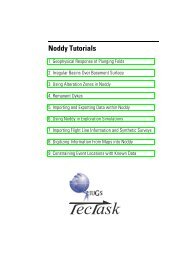Revised Eburnean geodynamic evolution of the ... - Tectonique.net
Revised Eburnean geodynamic evolution of the ... - Tectonique.net
Revised Eburnean geodynamic evolution of the ... - Tectonique.net
You also want an ePaper? Increase the reach of your titles
YUMPU automatically turns print PDFs into web optimized ePapers that Google loves.
36 S. Perrouty et al. / Precambrian Research 204– 205 (2012) 12– 39<br />
Fig. 17. Correlations between stratigraphic sequences, magmatism, deformations and mineralisations in south-west Ghana. The Cape Coast micaschists are not constrained<br />
by absolute or relative ages.<br />
presence <strong>of</strong> <strong>the</strong> Sefwi Group basement at shallow depths. It is<br />
<strong>the</strong>refore possible that D1 deformation also affect this basement,<br />
developing E-W trending structures under a regional N-S shortening<br />
regime. Some existing D1 structures may have been reactivated<br />
during D3 (NW-SE shortening) and initiated as transfer faults such<br />
as those observed in <strong>the</strong> Obuasi mine. D1 deformation also explains<br />
<strong>the</strong> presence <strong>of</strong> <strong>the</strong> E-W lineaments reported by Allibone et al.<br />
(2002a, Fig. 5, p. 72).<br />
Deformed granitoids such as those found in Sekondi (Loh et al.,<br />
1999), help constrain <strong>the</strong> timing <strong>of</strong> this Eoeburnean deformation<br />
phase (D1). Linear mag<strong>net</strong>ic anomalies in this granitoid are<br />
sub-parallel to <strong>the</strong> dominant S1 in <strong>the</strong> Birimian micaschist. Consequently,<br />
we suggest that this intrusion, dated at 2174 ± 2 Ma<br />
(Oberthür et al., 1998), is contemporaneous with D1. The undeformed<br />
Dixcove tonalite suggests that peak D1 deformation<br />
occurred before 2171 ± 2 Ma (Hirdes et al., 1992).<br />
5.2. Kumasi Group deposition (2154–2125 Ma)<br />
Eoeburnean tectonism produced magmatism between approximately<br />
2187 and 2158 Ma and deformation that occurred before<br />
2171 Ma. The Eoeburnean event predates deposition <strong>of</strong> <strong>the</strong> Kumasi<br />
Group sediments, and was only observed within <strong>the</strong> Sefwi Group<br />
basement. This places <strong>the</strong> deposition and lithification <strong>of</strong> <strong>the</strong> Kumasi<br />
Group between D1 and D3.<br />
The Kumasi Group within <strong>the</strong> Kumasi and <strong>the</strong> Akyem Basins<br />
(Fig. 1) formed under an extensional regime during D2 (Stage 4 <strong>of</strong><br />
Feybesse et al., 2006), where major faults (e.g. Ashanti, Akropong<br />
faults) behaved as primary basin forming structures and possible<br />
detachment surfaces prior to reactivation as D3 thrust faults. Direct<br />
evidence for an extensional origin for <strong>the</strong> Ashanti Fault is obscured<br />
by <strong>the</strong> strong overprinting (D3 thrust and D4 strike-slip movement,<br />
Allibone et al., 2002a). However, <strong>the</strong> opening <strong>of</strong> <strong>the</strong> Kumasi Basin<br />
required <strong>the</strong> generation <strong>of</strong> an extensional fault architecture that<br />
have been favourably orientated to undergo reactivation during D3<br />
shortening.<br />
The strong mag<strong>net</strong>ic and gravity contrasts across <strong>the</strong> Ashanti<br />
Fault (Figs. 5 and 16) suggest large amounts <strong>of</strong> vertical displacement<br />
have juxtaposed rocks with contrasting petrophysical properties.<br />
The absence <strong>of</strong> metamorphic gradient across <strong>the</strong> Ashanti Fault<br />
is not consistent with significant vertical thrust movement during<br />
D3 shortening. Consequently, we propose <strong>the</strong> Ashanti Fault<br />
was initiated as a half-graben during D2 deformation. Evidence<br />
<strong>of</strong> a widespread D2 extensional phase has also been identified in<br />
northwest Ghana, where De Kock et al. (2011) proposed a significant<br />
period <strong>of</strong> rifting between 2148 Ma and 2125 Ma. This timing<br />
is consistent with <strong>the</strong> deposition <strong>of</strong> <strong>the</strong> Kumasi Group between<br />
2154 ± 2 Ma (youngest U/Pb age on zircon found by Oberthür<br />
et al., 1998) and 2136 ± 19 Ma (Granitoid intrusion, U/Pb on zircon,<br />
Adadey et al., 2009).<br />
Adadey et al. (2009, p. 80) reported an early deformation in<br />
<strong>the</strong> Kumasi Group that was interpreted as pre-diage<strong>net</strong>ic slumping.<br />
This deformation is characterised by rare isoclinal fold-like<br />
structures that are coaxial with deformation that affected both<br />
<strong>the</strong> Birimian and Tarkwaian units (our D3). These folds could have<br />
resulted from <strong>Eburnean</strong> D3 deformation that intitiated after <strong>the</strong><br />
deposition <strong>of</strong> <strong>the</strong> Kumasi Group and before <strong>the</strong> Tarkwaian sedimentation.<br />
This hypo<strong>the</strong>sis is also consistent with observations <strong>of</strong><br />
an early bedding parallel cleavage in <strong>the</strong> Kumasi Group by Allibone<br />
et al. (2002a). This layer parallel fabric is interpreted it as resulting<br />
from bedding-parallel shearing (<strong>the</strong>ir D1, our D3) during <strong>the</strong> early<br />
<strong>Eburnean</strong> Orogeny that is absent in <strong>the</strong> Tarkwa Group.<br />
5.3. Tarkwa Group deposition (2107–2097 Ma)<br />
The Tarkwa Group occurs as a synclinal erosional remnant overlying<br />
<strong>the</strong> metavolcanic Sefwi Group in <strong>the</strong> Ashanti Belt. The timing<br />
and nature <strong>of</strong> <strong>the</strong> contact between <strong>the</strong> Tarkwa Group and <strong>the</strong><br />
Birimian Supergroup is not clear, but probably represents an unconformity<br />
or faulted contact. Both margins <strong>of</strong> <strong>the</strong> preserved Tarkwa<br />
Basin are represented by major faults. These faults may have been<br />
important during <strong>the</strong> early <strong>evolution</strong> <strong>of</strong> <strong>the</strong> Tarkwa Basin; however,<br />
strong reactivation obscures <strong>the</strong>ir early history.<br />
The presence <strong>of</strong> early deformation in <strong>the</strong> Kumasi Group<br />
metasediments is an indicator <strong>of</strong> <strong>the</strong> initiation <strong>of</strong> <strong>the</strong> <strong>Eburnean</strong><br />
Orogeny before <strong>the</strong> Tarkwaian deposition. However, <strong>the</strong> majority




